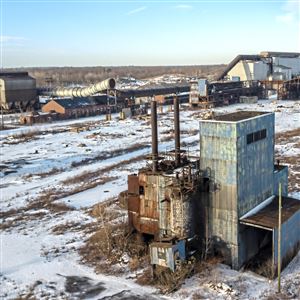America’s future prosperity may depend on what we do with some of our waste.
Across the United States, there are billions of tons of contaminated waste from coal and other mining operations — piles of leftover coal, toxic ash from burning coal and acidic mining waste. These sites are often eyesores or health hazards. They represent jobs lost in the past and water still contaminated today. Yet each of them offers an untapped resource for a wealth of minerals — and skilled jobs — that are essential to the industries that will power this century.
These critical minerals, including rare earth elements (REEs), are crucial components in clean energy technologies, from magnets for wind turbines to the batteries that power electric vehicles and make our grid more resilient to blackout. They’re also needed for a wide range of other high-growth industries—aerospace, defense, high-tech, and more. Yet today, America largely relies on other countries to provide and process our critical mineral supply.
Based on a 2020 USGS analysis, of the 35 critical minerals needed for clean energy technologies, the U.S. depends on imports for all but four of them. For 14 of these materials, we have no domestic production whatsoever. Instead, we rely on foreign extraction operations. Some of these operations rely on forced or child labor. Some generate unchecked air and water pollution. Some involve a toxic combination of both.
More than just a moral failure, this dependency poses a huge economic risk. Global demand for these minerals is set to rise exponentially over the next two decades, as virtually every country seeks out reliable supply chains to support clean energy transitions. Copper and REEs could see a 40% rise in demand, while the increase for nickel and cobalt could be up to 70%. Yet as the International Energy Agency recently reported, there’s a “looming mismatch” between the world’s needs and the available critical mineral supply.
That’s why the Biden administration is committed to building up reliable, sustainable supply chains for critical materials, with as much of it sourced from the United States as possible. The billions of tons of waste from our past mining operations give us a diversity of potential sources. Many of the waste sites across the nation have never been fully remediated and continue to pose environmental risks to some of our hardest-hit communities. By transforming mining waste into a building block for the clean energy economy, we can restore these sites, open them up for other industry or community uses and simultaneously create jobs and economic opportunity.
Pennsylvania is positioned to play a leading role in this new critical material supply chain. Estimates suggest we can extract 300,000 tons of REEs from coal ash in this state. Across broader Appalachia, acid mine drainage could provide between 400 and 1,700 tons of REE per year. And a 2020 study from Penn State University suggests there’s significant potential for recycling fossil waste from across the state into a valuable supply of cobalt.
Similar opportunities are cropping up in mining communities all over the country. Even if the economics make just a small percentage of these critical minerals recoverable, there is enough to spur domestic industries, such as batteries, magnets and semiconductor generation, and support a major part of our clean energy future for decades.
The DOE has already funded its first small-scale pilot projects for mineral production in four states — producing minerals from coal ash in Pennsylvania, acid mine drainage in West Virginia, coal refuse in Kentucky and coal waste and byproducts in North Dakota. Each continues to demonstrate the ability to produce high-purity material we can use to recover the metals and minerals needed for manufacturing. We’re also sponsoring research to optimize processing technologies to eliminate or substantially reduce toxic and caustic chemicals often used in these processes, to enable a truly responsible, sustainable supply chain.
But we need help to truly turn this waste into a resource for critical minerals. In particular, we need bold entrepreneurs to build the facilities that can collect and process these critical minerals. Last week, the Department of Energy put out a call for ideas regarding design, construction and operation of such a facility, which will guide planning for the $140 million investment in a rare earth element extraction and refining facility included in President Joe Biden’s Bipartisan Infrastructure Law. We’re now looking for private sector partners who can help us take the next steps.
Americans have long turned problems into enormous opportunities — because we are a nation of builders and innovators. By upcycling our legacy mining waste, we can create another outsized opportunity, while satisfying a national priority. We have the resources, expertise and skilled workforce to build a first-of-its-kind mineral production supply chain. There is no better time for it.
Jennifer Wilcox, Ph.D., serves as principal deputy assistant secretary for the U.S. Department of Energy’s Office of Fossil Energy and Carbon Management.
First Published: February 26, 2022, 5:00 a.m.















